-
Membership
Membership
Anyone with an interest in the history of the built environment is welcome to join the Society of Architectural Historians -
Conferences
Conferences
SAH Annual International Conferences bring members together for scholarly exchange and networking -
Publications
Publications
Through print and digital publications, SAH documents the history of the built environment and disseminates scholarship -
Programs
Programs
SAH promotes meaningful engagement with the history of the built environment through its programs -
Jobs & Opportunities
Jobs & Opportunities
SAH provides resources, fellowships, and grants to help further your career and professional life -
Support
Support
We invite you to support the educational mission of SAH by making a gift, becoming a member, or volunteering -
About
About
SAH promotes the study, interpretation, and conservation of the built environment worldwide for the benefit of all
Study Day: Henri Labrouste and Le Corbusier Exhibitions at MoMA
For a brief period this spring, an unprecedented amount of temporary exhibition space at the Museum of Modern Art was simultaneously devoted to two seminal figures of modern architecture, Henri Labrouste and Le Corbusier (Charles-Édouard Jeanneret). As a recipient of the Society’s Scott Opler Endowment for New Scholars Study Tour Fellowship, I had the exceptional experience of touring the exhibits with their curators and a group of architectural historians and enthusiasts. Each exhibition presented a wealth of architectural drawings, models, photographs, and related ephemeral materials, including Labrouste’s silk laurel wreath from the École des Beaux-Arts and Le Corbusier’s glass bottles used in his Purist paintings. While our tour leaders presented the participants with great insights and historical background to many of the individual objects in the exhibitions, this report will focus on observations regarding the broader questions of exhibit conception, organization, and design, rather than individual objects or building projects.
Our day began in the lobby of the Museum of Modern Art, where we met Barry Bergdoll, Philip Johnson Chief Curator of Architecture and Design. After traversing the so-called “Bauhaus staircase” we arrived at the entrance to the Henri Labrouste: Structure Brought to Light exhibition, curated by Prof. Bergdoll in association with Corinne Bélier and Marc Le Cœur. We toured the three sections of the exhibition and concluded with a brief tour of the Architecture and Design galleries.
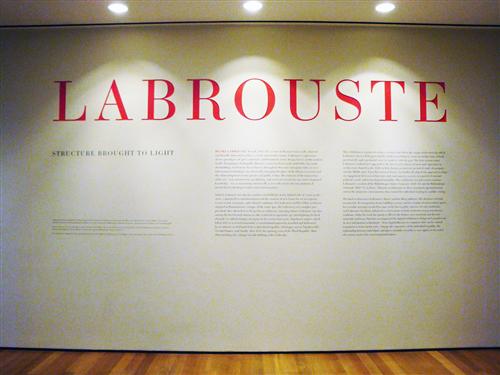
Prof. Bergdoll began our tour with an answer to the seemingly fundamental question about the genesis of the exhibit: “Why Labrouste at MoMA?” While he presented many reasons for the exhibition including the importance placed on Labrouste by the early critics and historians of modern architecture and the desire to expose students and the general public to his work, Prof. Bergdoll also shared with us that a Labrouste exhibition was proposed in the early years of the department’s history – the Museum of Modern Art was long due for an exhibit devoted to this important nineteenth-century architect.
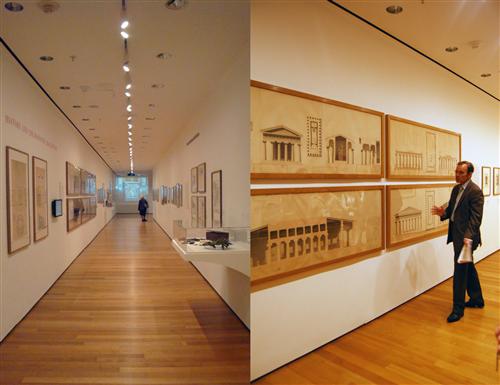
We explored the three sections of the exhibition, beginning with the first gallery devoted to Labrouste’s development as a young architect and student at the École des Beaux-Arts in Paris and his time in Rome as the recipient of the Grand Prix de Rome. Proceeding to the middle section of the exhibition, devoted to Labrouste’s two major library projects, one noticed the novel ways in which the exhibition presented architectural drawings and other materials. Specifically, exhibition designers created tables in the style of the Bibliothèque Sainte-Geneviève to display drawings of the building itself. An opening containing models of the two projects joined the two galleries and ingeniously drew a physical connection between the pair of Parisian libraries. The final gallery of the exhibit looked beyond Labrouste to his contemporaries, his later influences, and the historiography of his work including the landmark The Architecture of the École des Beaux-Arts exhibit at the Museum of Modern Art in 1975.
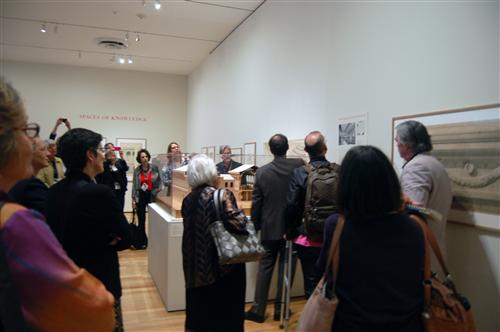
After a break for lunch, we began our tour of Le Corbusier: An Atlas of Modern Landscapes with Jean-Louis Cohen, guest curator of the exhibit in association with Prof. Bergdoll and Sheldon H. Solow Professor in the History of Architecture at the Institute of Fine Arts, New York University. I was particularly interested in this tour as I am teaching two concurrent advanced undergraduate seminars on the architecture, art, and writings of Le Corbusier at Connecticut College.
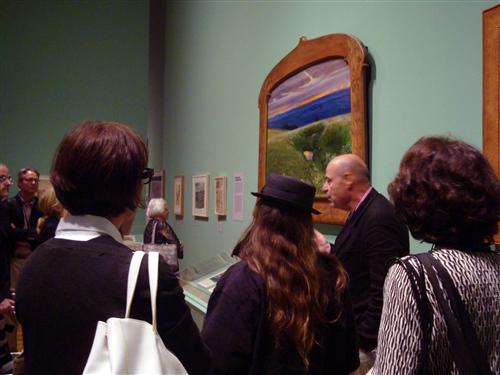
Our tour began with a discussion of the genesis of this exhibit—the first full retrospective of Le Corbusier’s work at the Museum of Modern Art—and the challenges that came with this exhibition. With so many exhibits devoted to his work, Prof. Cohen explained his desire to focus on Le Corbusier’s relationship with landscape. While this element of landscape is certainly a clear thread that runs throughout the exhibition—from Le Corbusier’s arrangement of objects in his paintings to the line drawings the exhibit designers employed in the windows of full-scale interior spaces to give the visitor a sense of the space beyond—the exhibition is also clearly a retrospective. This is in part due to the exceptional quality and quantity of objects displayed from the collection of the Fondation Le Corbusier in Paris.
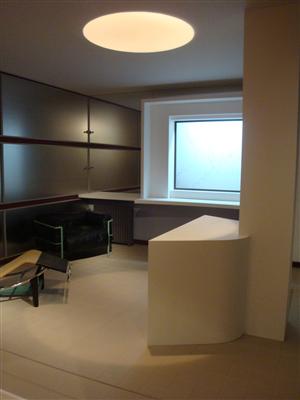
Prof. Cohen additionally discussed his vision for the exhibit, his choice to feature both well known and unfamiliar objects, and his goal to create something that would be compelling for both scholars and the general public alike. He also explained that there was a concerted effort to let Le Corbusier’s work speak for itself. Notably no digital reconstructions are included in the exhibition and almost all the architectural models displayed were produced by Le Corbusier and his atelier.
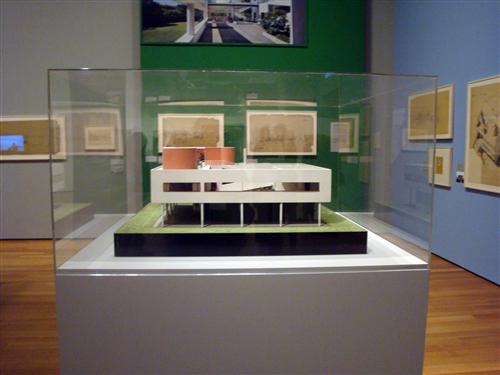
One design consideration discussed during both tours was the use of color. For the Labrouste exhibition, Prof. Bergdoll noted the use of a gray stonelike color for the walls in the first two sections and white for the final section. The color choice was intended to highlight both Labrouste’s drawings and to mark a differentiation between the sections focused on his work and the final section, which looked to contemporary and comparative examples. While color in the Labrouste exhibit was subtle, in the Le Corbusier exhibition, it plays a major role in the visitor’s interaction with the gallery spaces and ultimately with the objects themselves. The curators drew directly from Le Corbusier’s so-called “color keyboard” to select a variety of subtle as well as vibrant colors to visually mark the development of Le Corbusier’s work from Purism to the postwar.
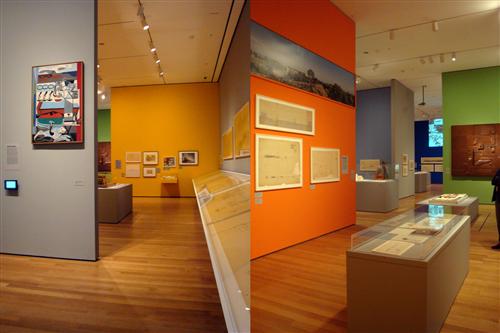
The tour of both exhibits was an incredible experience. Rarely, if ever, have two architectural exhibitions of this importance been mounted simultaneously in the same city, let alone at the same institution. These exhibitions present a trove of exceptional objects that tell a compelling history of two the most important architects of the modern era. The insights shared by Profs. Bergdoll and Cohen not only provided greater knowledge about these extraordinary artifacts, but also gave a deeper appreciation for the choices made in the process of curation. Learning this information about the Le Corbusier exhibition was especially valuable for me as it will directly shape the development and refinement of my fall undergraduate seminar. While this course will only look at the postwar architecture of the Franco-Swiss architect, the exhibit has already transformed my understanding of his architectural production. I look forward to sharing much of this new insight with my students this fall both in the classroom and at the exhibition, which we will visit in September.
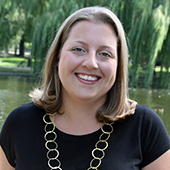 Emily Morash, Visiting Instructor, Connecticut College; Ph.D. Candidate, Brown University
Emily Morash, Visiting Instructor, Connecticut College; Ph.D. Candidate, Brown UniversityEmily Morash is a Ph.D. candidate at Brown University in the History of Art and Architecture as well as a visiting instructor in architectural studies at Connecticut College. She received a B.A. in art history and Italian from Smith College and a master’s degree in architectural history from the University of Virginia. She is currently completing a dissertation, Reconstructing Italian Domestic Architecture: Gio Ponti and Lo Stile, 1941-1947, that examines the development of domestic architecture and reconstruction solutions in Milan during and immediately following World War II.



Leave a commentOrder by
Newest on top Oldest on top